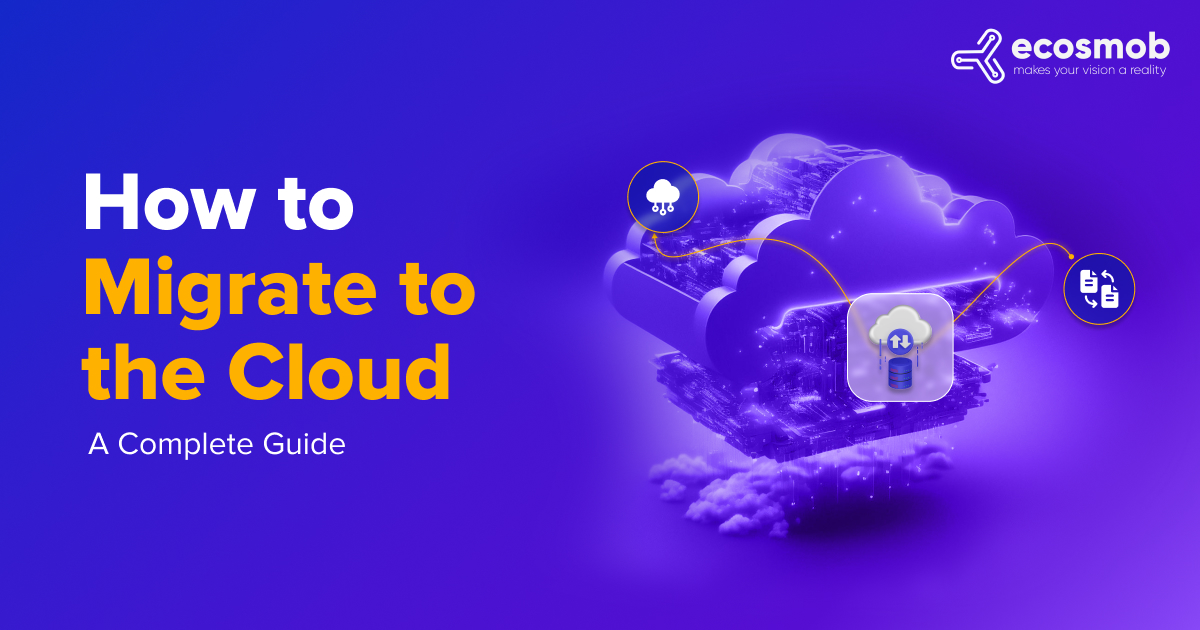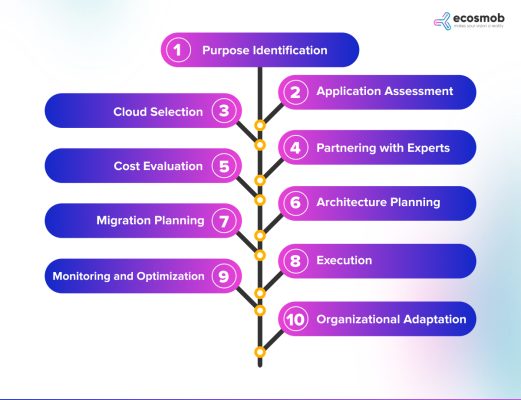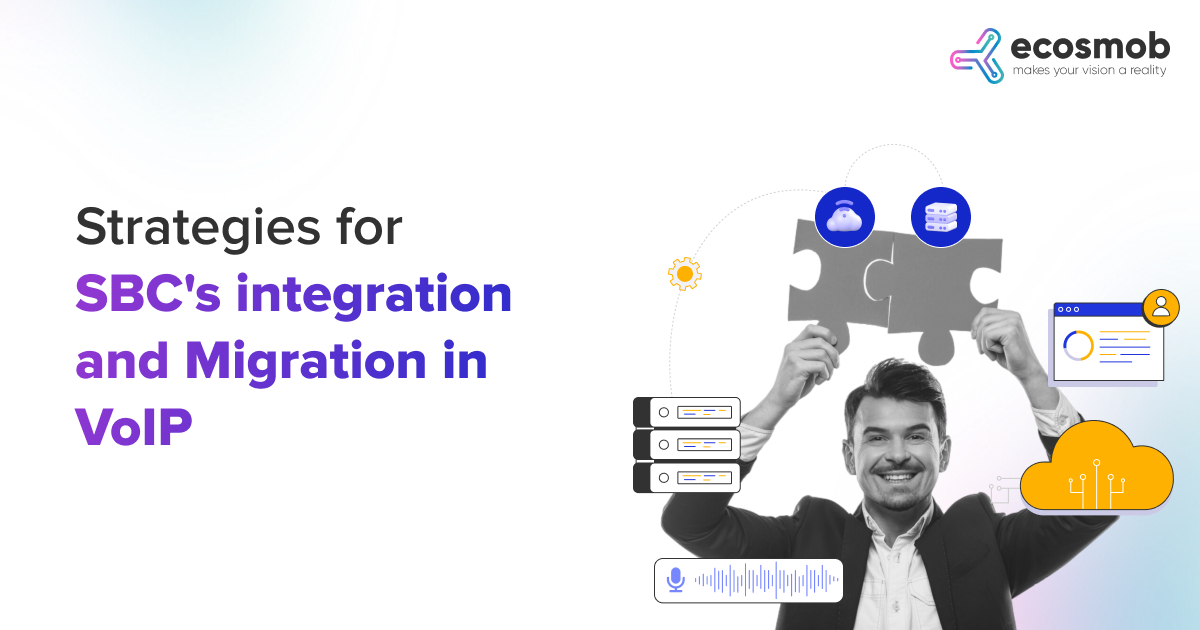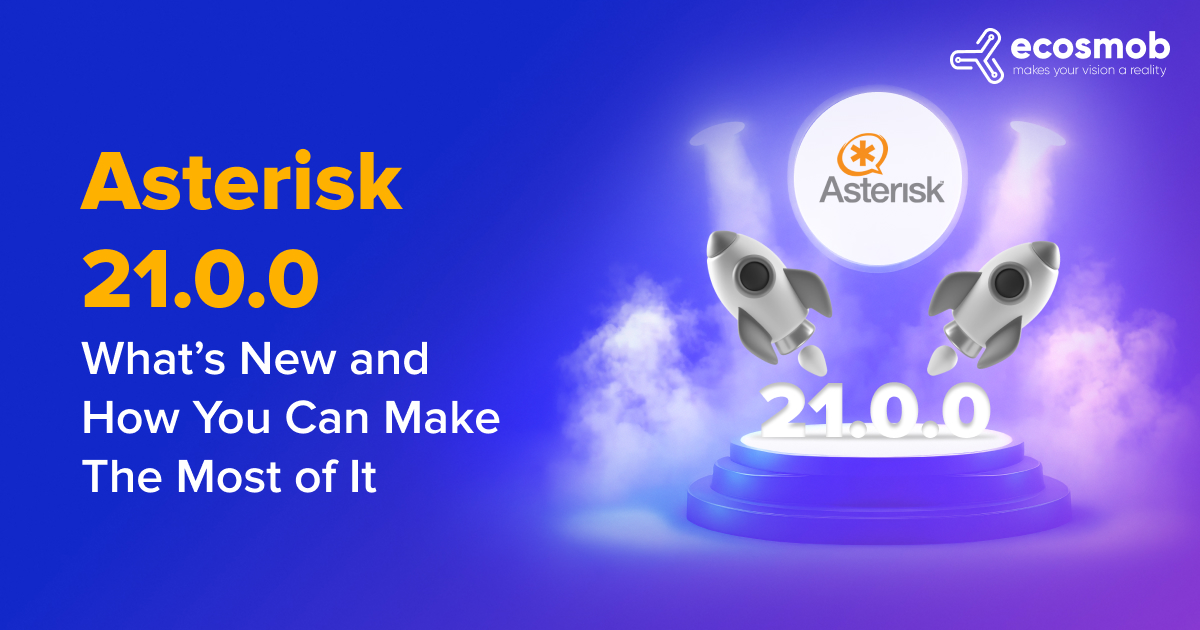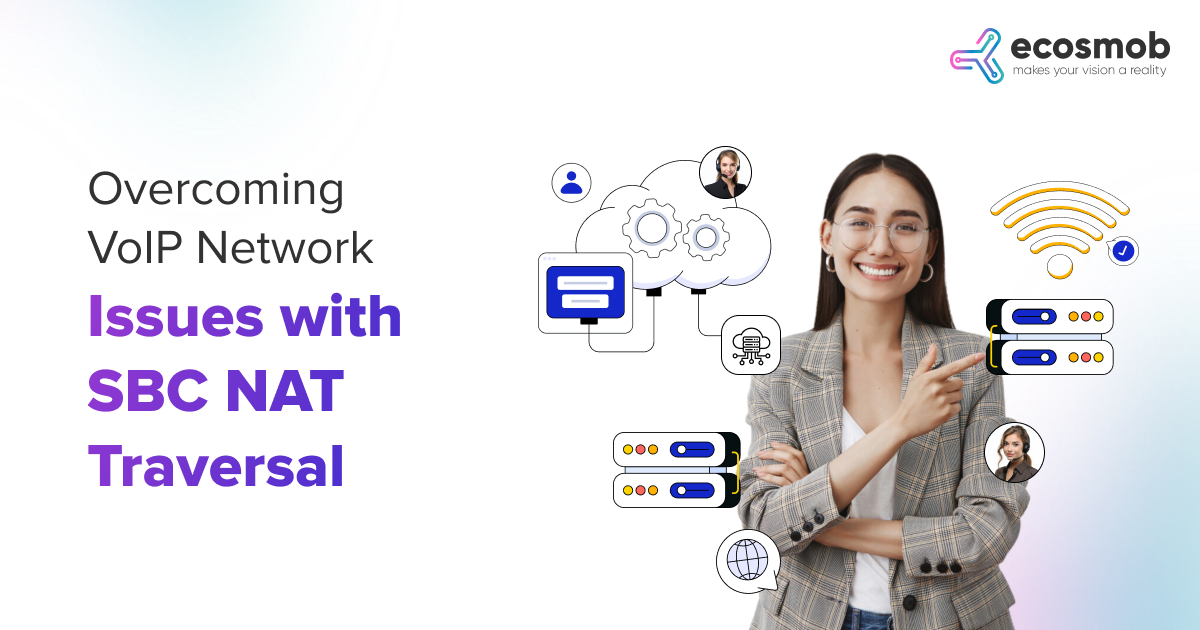The global pandemic has accelerated the need to transition swiftly towards cloud environments, prompting a surge in demand for expert cloud migration services, including the need to hire AWS migration engineers. RTC solution provider companies like Ecosmob Technologies are at the forefront, guiding through the intricacies of the cloud migration process and revamping business operations’ efficiency, flexibility, and innovation.
As a self-service, on-demand platform, cloud computing is pivotal in facilitating comprehensive digital transformation. In this era of constant change and uncertainty, the skills of AWS migration engineers are essential for organizations to innovate and adapt. Understanding what migration in cloud computing entails is the first step in this journey, and partnering with seasoned experts from AWS, with the support of AWS migration engineers and Ecosmob, can ensure a successful transition into the cloud environment.
Before moving further, Let’s understand Cloud migration.
Wondering to explore the benefits of migrating to the cloud today?
What is Cloud Migration?
Have you ever heard of Cloud migration? It’s like moving digital business operations into the cloud, transferring data, applications, and IT processes from on-premises data centers to cloud-based infrastructure. This shift aims to enhance scalability, flexibility, and cost-efficiency, leveraging the cloud’s vast resources and advanced technologies. Cloud migration can vary in complexity and scale, often requiring careful planning and execution with the support of cloud migration experts.
The execution process has five main stages:
Planning, Migration, Operation, Optimization, and Preparation.
This procedure can also transfer data from one cloud service to another. More importantly, cloud migration is not just about transferring data from nearby data centers to well-known public cloud service providers like Google Cloud, AWS, or Microsoft Azure; it offers much more.
What are The Different Types of Cloud Migration?
Cloud migration involves moving digital business operations into the cloud to leverage cloud computing environments’ flexibility, scalability, and efficiency. This procedure is approached in several ways, depending on a business’s specific needs and goals.
Now, onto the juicy part – Below are the primary types of cloud migration, each with its unique approach and methodology:
- Lift and Shift (Rehosting): This is one of the most basic methods, where your existing applications are moved to the cloud with minimal changes. It’s often the first step for your business if you want to migrate quickly without re-architecting their applications.
- Refactoring / Re-architecting: In this approach, applications are modified or wholly re-architected to leverage cloud-native features and capabilities fully. It is more complex and costly but can yield significant benefits for scalability, performance, and cost-efficiency.
- Replatforming: This method involves optimizing the applications for the cloud but without a complete overhaul. It balances the lift and shift model and complete refactoring, allowing you to gain some cloud benefits without a significant investment in redevelopment.
- Repurchasing (Drop and Shop): This involves moving to a different product, typically a cloud-native solution, and often applies to moving from on-premise legacy applications to SaaS (Software as a Service) applications. This strategy can lead to faster innovation cycles and lower operational burdens.
- Retire: Identifying IT assets that can be turned off during migration and are no longer helpful. It helps optimize the resources and focus on the ones that are truly necessary for your business.
Each migration strategy requires careful planning and execution and often the assistance of cloud migration experts or service providers. Consider getting assistance from the leading cloud migration service providers. Their expertise in planning and executing a migration strategy will align the best with your business objectives, making sure a smooth transition to the cloud.
Why is Cloud Migration Important?
The journey to cloud adoption encompasses more than just a technical shift. It involves a thorough evaluation to determine the suitability of workloads for the cloud, considering aspects like performance requirements, dependencies, and architectural design. Cloud migration is essential to achieve real-time updated performance and efficiency. Here are some of the critical elements that make cloud migration a necessity.
Let’s break it down!
-
Cost Efficiency
Cloud migration can significantly reduce the costs of maintaining physical servers and infrastructure. By leveraging cloud migration services, it can switch to a more scalable and flexible pricing model based on consumption, leading to potential cost savings and more efficient resource use. AWS Cloudendure offers a pay-as-you-go pricing model that leads to cost savings compared to maintaining physical servers and infrastructure.
-
Scalability and Flexibility
Cloud migration service providers offer solutions that allow you to scale the resources. AWS provides on-demand resource allocation, enabling enterprises to scale up/down quickly based on their needs. This flexibility is crucial for handling varying workloads and optimizing performance and costs.
-
Enhanced Collaboration and Accessibility
Moving to the cloud enables better collaboration among your employees by allowing them to access data and applications anytime. This accessibility enhances productivity and supports remote and hybrid work models.
-
Improved Disaster Recovery and Data Protection
Cloud migration companies often provide robust disaster recovery solutions and data protection mechanisms as part of their services. It can enhance your resilience against data loss and system failures, ensuring long-term business continuity.
-
Innovation and Competitive Advantage
Cloud migration experts can help your business leverage the latest technologies and innovations. This adoption improves services and products, giving your business a competitive edge.
-
Streamlined Operations
Leading cloud migration service providers assist in streamlining operations by automating tasks and integrating various functions. It can lead to improved efficiency and reduced chances of human error.
And we’re not done yet – Besides being a technical process, successful cloud migration is a crucial business activity and must begin with well-defined company goals and use cases.
Success in cloud migration? It’s not just about tech wizardry. Let’s look at AWS’s benefits in Migrating to the Cloud.
What Are the Key Benefits of AWS When Migrating to the Cloud?
Cloud migration, a pivotal aspect of modern IT strategies, involves transitioning on-premises applications and data to cloud infrastructure, leveraging leading cloud migration service providers. This strategic move drives the quest for enhanced elasticity, self-service provisioning, redundancy, and the efficiency of a pay-per-use model, hallmarks of what migration in cloud computing entails.
The core advantages of engaging cloud migration experts and companies in this process are significant. The aim is to optimize the hosting of applications and data. The optimization focuses on achieving the most cost-effective, high-performing, secure IT environment.
Several vital benefits underscore the cloud migration process:
-
Enhanced Agility and Flexibility
Cloud platforms, designed for on-demand resource allocation, empower you to deploy and scale operations instantaneously, eliminating the wait associated with traditional infrastructure procurement.
-
Innovation Enablement
The cloud is a fertile ground for innovation, allowing you to experiment with new architectures and workloads with minimal financial risk, thanks to the reduced need for upfront infrastructure investment.
-
Local Resource Optimization
By migrating to the cloud, you can alleviate the strain on local data centers, redirecting routine or less critical workloads to the cloud. This strategic shift can delay, or even negate, the need for physical data center expansions, optimizing existing infrastructure.
-
Improved Workload Performance
The global distribution of cloud data centers minimizes latency issues. For international workloads, ensure superior performance by hosting services closer to end-users and adhering to regional regulatory standards.
-
Improve Security
AWS offers end-to-end security and privacy features built into the cloud platform. It provides comprehensive controls, auditing capabilities, and broad security accreditations to maintain security and data protection.
-
Global Reach
With AWS’s extensive global cloud infrastructure, you can deploy its applications in multiple regions worldwide with just a few clicks. This global reach improves the performance and availability of applications for a worldwide audience.
-
Rich Ecosystem of Services
AWS Cloudendure supports various applications, from computing and storage to machine learning, analytics, and IoT. This rich ecosystem allows you to innovate and evolve their applications efficiently.
Understanding these benefits clarifies the meaning of cloud migration. It underscores the importance of partnering with leading cloud migration service providers to navigate the complexities of the cloud migration process effectively. Different cloud migration strategies, including re-hosting, re-platforming, and re-factoring, offer tailored solutions to meet specific organizational needs, further highlighting the versatility and potential of cloud migration in enhancing your business operations.
Now, let’s talk about AWS Migration – the superhero of cloud computing.
Key AWS Services for Cloud Migration
AWS offers a suite of services to facilitate efficient cloud migration. These services provide the necessary tools and infrastructure to support numerous workloads and applications. AWS CloudEndure is a tool that offers a pay-as-you-go pricing model, ensuring your business can benefit from the full potential of cloud computing.
-
AWS-RDS (Relational Database Service)
AWS-RDS makes setting up and operating a relational database in the cloud easy. It provides cost-saving and resizable capacity while automating time-consuming administration tasks such as patching, hardware provisioning, database setup, and backups. This service enhances the scalability and availability of database applications.
-
AWS DocumentDB
This fast, scalable, highly available, and entirely managed document database service supports MongoDB workloads. AWS DocumentDB is designed to be compatible with existing MongoDB applications and tools, allowing you to bring their MongoDB workloads to AWS without changing their applications.
-
AWS S3 Storage
Amazon S3 provides data availability, industry-leading security, scalability, and performance. Businesses use S3 for various purposes, such as website hosting, backup and recovery, archiving, and big data analytics. S3’s durability, high availability, and scalable storage make it an excellent choice for cloud storage needs.
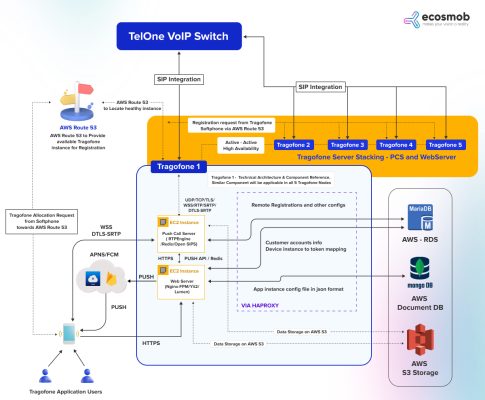
Incorporating AWS services like AWS Migration Hub, AWS MAP (Migration Acceleration Program), and CloudEndure can significantly enhance your business operations’ efficiency, flexibility, and innovation. AWS-RDS and DocumentDB provide robust and scalable database solutions, while S3 offers secure and scalable storage options.
Simultaneously, be ready to tackle many typical obstacles encountered during AWS in cloud migration. Let’s discuss it!
What are the Key Challenges in Cloud Migration?
Cloud migration involves transferring data, applications, and workloads from on-premises infrastructure to cloud environments. This process, guided by cloud migration experts and service providers, is influenced by various factors and aims to leverage the cloud’s scalability, efficiency, and flexibility. Let’s look at the challenges you might face on this exciting journey.
-
Strategic Planning
A successful cloud migration requires a well-thought-out strategy beyond moving to the cloud. It involves understanding how the cloud can transform your operations and ensuring the migration aligns with broader objectives. Implementing an AWS cloud migration strategy is crucial for companies migrating to AWS.
-
Application Performance
Post-migration, some applications may not perform as efficiently in the cloud as on-premises due to various factors such as latency, security, or compliance issues. It necessitates thoroughly evaluating application architectures and their suitability for cloud environments. Utilizing AWS and cloud migration services can help optimize application performance post-migration.
-
Suitability
Migrating applications requires evaluating technical, business, compliance, data sovereignty, and core needs. Businesses often hire AWS experts to assess and ensure the suitability of applications for the AWS cloud.
-
Exit Strategy
A clear plan for potentially moving applications and data out of the cloud is essential. This “cloud exit strategy” should address technical transitions, data management, and legal considerations to ensure a smooth process if repatriation becomes necessary.
-
Infrastructure Design
Effective cloud migration relies on optimal infrastructure design and provisioning. Inadequate or improper setup can lead to poor performance and migration failures, highlighting the need for expert cloud architecture and engineering skills. AWS CloudEndure and AWS Migration Hub are among the best cloud migration tools for ensuring adequate infrastructure design and provisioning.
-
Staff Expertise
The success of cloud migration also hinges on having a skilled team. Staff training in cloud management and security practices is vital, and in some cases, partnering with experienced cloud service providers may be beneficial to bridge skill gaps. Tools like AWS MAP (Migration Acceleration Program) can offer additional support and resources for staff training and migration planning.
What makes a Successful Cloud Migration?
A successful cloud migration, as highlighted by a 2017 Forrester Consulting study, involves fewer than 40% of organizations achieving their migration and operational cost objectives. Key to this success is establishing a clear vision and business case, with stakeholder alignment, to guide the selection of an appropriate cloud migration strategy.
Expert guidance is often essential for navigating these financial complexities and ensuring accurate cost projections. Comprehensive due diligence, encompassing cost, licensing, and future scalability, is foundational to successful cloud migration. Beyond technical and financial aspects, the human element—through effective communication, employee engagement, and training—is critical yet frequently overlooked. Ensuring these components are in place can significantly enhance the likelihood of successfully migrating to cloud computing environments.
How does the Cloud Migration process work?
Cloud migration is an essential strategy for enterprises looking to leverage the scalability, efficiency, and cost-effectiveness of cloud computing. The process involves steps tailored to meet specific business needs and goals. Here’s a streamlined overview of how it works:
-
Purpose Identification
The initial phase involves understanding the ‘why’ behind the migration. You must establish clear, measurable objectives for moving to the cloud, ensuring a tangible benefit to the migration effort.
-
Application Assessment
Companies must evaluate their existing applications and workloads to determine their suitability for the cloud, considering factors like performance, security, and compliance requirements.
-
Cloud Selection
After identifying the applications to migrate, your businesses must choose the most appropriate cloud model (public, private, hybrid, multi-cloud) and service (IaaS, PaaS, SaaS) for their needs.
-
Partnering with Experts
Selecting a proven cloud migration partner is crucial. The chosen partner should have a solid track record and expertise in cloud migrations to ensure a smooth transition.
-
Cost Evaluation
Understanding the financial implications is critical. It involves analyzing the costs associated with the migration and ongoing cloud services and aligning them with your business budget.
-
Architecture Planning
For IaaS migrations, designing exemplary architecture is critical. It requires skilled cloud architects to develop an environment that meets the workload’s performance, security, and scalability needs.
-
Migration Planning
The ‘when’ and ‘how.’ You must outline a detailed migration plan, including data migration, testing, validating phases, and a clear cutover strategy and rollback plans for any issues.
-
Execution
With planning complete, the actual migration can commence. It involves moving data and workloads to the cloud and extensive testing to meet performance and security standards.
-
Monitoring and Optimization
Post-migration, it’s essential to continuously monitor cloud workloads to ensure they meet predefined KPIs and performance metrics, making adjustments as necessary.
-
Organizational Adaptation
Finally, your businesses need to reallocate resources or reassign staff roles to align with the new cloud-based operational model, optimizing technical and human resources for the cloud environment.
Cloud Migration Trends:
It’s this incredible phenomenon where cloud migration is increasingly pivotal in digital transformation strategies, with machine learning, big data analytics, and artificial intelligence as key drivers.
You know how the pandemic turned everything upside down? The global pandemic accelerated cloud adoption across every industry; the need for scalability, enhanced user experiences, and remote work capabilities has pushed businesses toward cloud adoption. The trend is evolving from single-cloud to hybrid and multi-cloud approaches, enabling organizations to leverage the distinct advantages of various cloud service providers. Additionally, financial management through FinOps and a growing emphasis on sustainability and social responsibility shape cloud migration decisions.
So, what are you waiting for? Let’s make your cloud migration journey as smooth as possible!
Ready to Migrate to the Cloud?
The journey towards cloud optimization is not merely a trend but a strategic necessity. Ecosmob stands out as one of the leading cloud migration service providers, offering a comprehensive suite of services that cater to diverse organizational needs. With a deep understanding of the AWS cloud migration process and a team of seasoned cloud migration experts, including highly skilled AWS developers, Ecosmob ensures a seamless transition for your business, aiming to leverage the myriad benefits of AWS in cloud computing.
Hiring AWS developers has become integral to Ecosmob’s strategy to provide specialized and advanced cloud migration solutions. These developers bring a wealth of knowledge and expertise in AWS services, enabling Ecosmob to design and implement customized cloud solutions that meet each client’s needs. From understanding the nuances of migration in cloud computing to executing complex cloud migration strategies, Ecosmob’s proficiency, bolstered by its dedicated AWS developers, helps your business minimize disruption and maximize efficiency. Whether it’s about enhancing scalability and flexibility or driving innovation, Ecosmob’s tailored solutions, enriched by the expertise of AWS developers, resonate with your company’s unique requirements, making them an invaluable partner in the cloud migration journey.
Ready to schedule your cloud migration consultation?
FAQs
What is Cloud migration?
Cloud migration moves digital business operations into the cloud, including data, applications, and IT processes. It involves transferring data and applications from an on-premises data center to a cloud computing environment or moving from one cloud to another.
Why do Businesses choose AWS Cloud migration services?
Organizations are adopting AWS cloud migration to reduce operational costs, increase scalability, enhance flexibility, improve efficiency, and improve disaster recovery, leveraging the expertise of specialized service providers for a smooth transition.
What are the Cloud migration types?
There are different types of cloud migration, including lift-and-shift (rehosting), refactoring (re-platforming), revising (re-architecting), rebuilding, and replacing. Each type has its own set of benefits and is chosen based on the needs and goals of the business.
How can AWS Migration Services and Experts help in migration?
AWS Migration Services and experts facilitate the migration process, offering guidance, technical expertise, and resources. Hiring AWS developers or experts can help design a tailored migration plan, address complex migration challenges, and optimize AWS resources post-migration for performance and cost.
How do I choose the optimal AWS Cloud migration service provider?
When selecting an AWS cloud migration service provider, prioritize their proficiency and track record in AWS environments, including their experience in handling migrations of similar scale and complexity and the range of AWS services they support. Opt for providers renowned for their AWS migration expertise and success stories within your sector.





